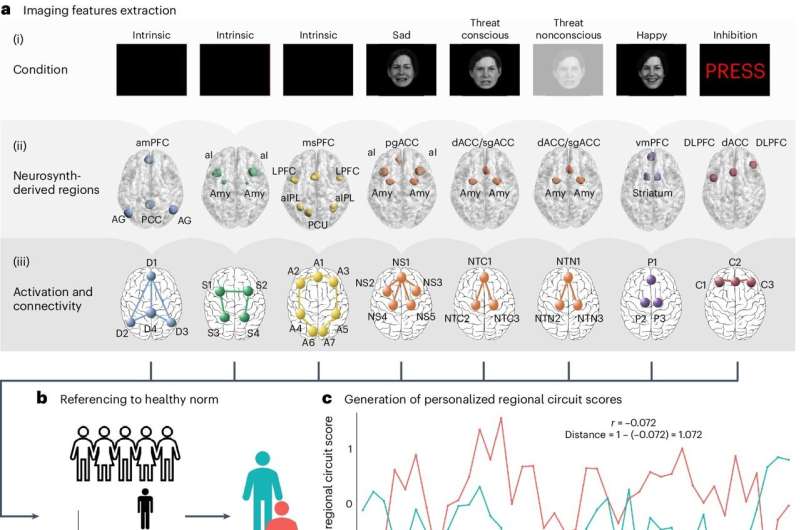
Credit: Unsplash/CC0 Public domain
In the not-so-distant future, a screening assessment for depression may include a rapid brain scan to identify the best treatment.
Brain imaging combined with machine learning can reveal subtypes of depression and anxiety, according to a new study led by researchers at Stanford Medicine. The study, published June 17 in the journal Natural medicinesorts depression into six biological subtypes, or “biotypes,” and identifies treatments that are more or less likely to work for three of these subtypes.
Better methods for matching patients with treatments are desperately needed, said the study’s lead author, Leanne Williams, Ph.D., Vincent VC Woo Professor, professor of psychiatry and behavioral sciences and director of the Center for Precision Mental Health at Stanford Medicine. and well-being. Williams, who lost her partner to depression in 2015, has focused her work in the field of precision psychiatry.
About 30% of people with depression have what is called treatment-resistant depression, meaning that several types of medications or therapies have failed to improve their symptoms. And for nearly two-thirds of people with depression, treatment fails to completely return their symptoms to healthy levels.
This is partly because there is no effective way to know which antidepressant or type of therapy might help a given patient. Medications are prescribed using a trial-and-error method, so it can take months or even years to find a medication that works, if it ever does. And spending so much time trying treatment after treatment, only to feel no relief, can make depression symptoms worse.
“The goal of our job is to figure out how to get it right the first time,” Williams said. “It’s very frustrating to be in the depression field and not have a better alternative to this one-size-fits-all approach.”
Biotypes predict treatment response
To better understand the biology underlying depression and anxiety, Williams and colleagues assessed 801 study participants who had previously been diagnosed with depression or anxiety using imaging technology known as the name functional MRI, or fMRI, to measure brain activity.
They scanned the volunteers’ brains at rest and while they were engaged in different tasks designed to test their cognitive and emotional functioning. The scientists focused on brain regions and the connections between them that were already known to play a role in depression.
Using a machine learning approach known as cluster analysis to group patients’ brain images, they identified six distinct activity patterns in the brain regions studied.
The scientists also randomly assigned 250 of the study participants to receive one of three commonly used antidepressants or behavioral talk therapy. Patients with one subtype, characterized by hyperactivity in cognitive regions of the brain, showed the best response to the antidepressant venlafaxine (commonly known as Effexor) compared to those with other biotypes.
Those in another subtype, whose resting brains showed higher levels of activity in three regions associated with depression and problem solving, achieved greater symptom relief with behavioral therapy. word. And those with a third subtype, who had lower levels of resting activity in the brain circuit that controls attention, were less likely to see improvement in their symptoms from talk therapy than those with other biotypes.

Overview of the participant-level image processing and analysis pipeline. Credit: Natural medicine (2024). DOI: 10.1038/s41591-024-03057-9
Biotypes and their response to behavioral therapy make sense based on what they know about these brain regions, said Jun Ma, M.D., Ph.D., the Beth and George Vitoux Professor of Medicine at the University of Illinois in Chicago and one of the authors of the study.
The type of therapy used in their trial teaches patients the skills to better solve everyday problems, so the high levels of activity in these brain regions may allow patients with this biotype to adopt new skills more easily .
As for those who have lower activity in the region associated with attention and engagement, Ma said it’s possible that pharmaceutical treatment aimed at addressing that lower activity first could help these patients benefit more from talk therapy.
“To our knowledge, this is the first time that we have been able to demonstrate that depression can be explained by different disturbances in brain function,” Williams said. “Essentially, this is a demonstration of a personalized medical approach to mental health based on objective measures of brain function.”
In another study, Williams and his team showed that the use of fMRI brain imaging improved their ability to identify individuals likely to respond to antidepressant treatment. In this study, scientists focused on a subtype they call the cognitive biotype of depression, which affects more than a quarter of people with depression and is less likely to respond to standard antidepressants.
By identifying people with the cognitive biotype using fMRI, researchers accurately predicted the likelihood of remission in 63% of patients, compared to 36% accuracy without using brain imaging. This improved accuracy means providers may be more likely to get the treatment right the first time. Scientists are currently investigating new treatments for this biotype in hopes of finding more options for those who don’t respond to standard antidepressants.
Further explorations of depression
Different biotypes also correlate with differences in symptoms and task performance among trial participants. For example, people with overactive cognitive regions of the brain had higher levels of anhedonia (inability to feel pleasure) than those with other biotypes; they also performed worse on executive function tasks. Those in the subtype who responded best to talk therapy also made errors on executive function tasks but performed well on cognitive tasks.
One of the six biotypes discovered in the study showed no notable differences in brain activity in the imaged regions compared to the activity of people without depression. Williams thinks they probably haven’t explored the full range of brain biology underlying this disorder. Their study focused on regions known to be involved in depression and anxiety, but there could be other types of dysfunction in this biotype that their imaging did not capture. .
Williams and his team are expanding the imaging study to include more participants. She also wants to test more types of treatments across all six biotypes, including medications that are not traditionally used to treat depression.
His colleague Laura Hack, MD, PhD, assistant professor of psychiatry and behavioral sciences, began using the imaging technique in her clinical practice at Stanford Medicine through an experimental protocol. The team also wants to establish easy-to-follow standards for the method so that other practicing psychiatrists can begin implementing it.
“To truly move the field toward precision psychiatry, we need to identify treatments that are most likely to be effective for patients and get them on treatment as soon as possible,” Ma said. “Having information about their brain function , particularly the validated signatures we evaluated in this study, would help inform more precise treatment and prescriptions for individuals.”
Columbia University researchers; Yale University School of Medicine; the University of California, Los Angeles; University of California, San Francisco; the University of Sydney; MD Anderson of the University of Texas; and the University of Illinois at Chicago also contributed to the study.
More information:
Leonardo Tozzi et al, Personalized brain circuit scores identify clinically distinct biotypes in depression and anxiety, Natural medicine (2024). DOI: 10.1038/s41591-024-03057-9
Provided by Stanford University Medical Center
Quote: Six distinct types of depression identified in study combining brain imaging and machine learning (June 17, 2024) retrieved June 18, 2024 from https://medicalxpress.com/news/2024-06-distinct-depression-combining -brain-imaging. HTML
This document is subject to copyright. Except for fair use for private study or research purposes, no part may be reproduced without written permission. The content is provided for information only.